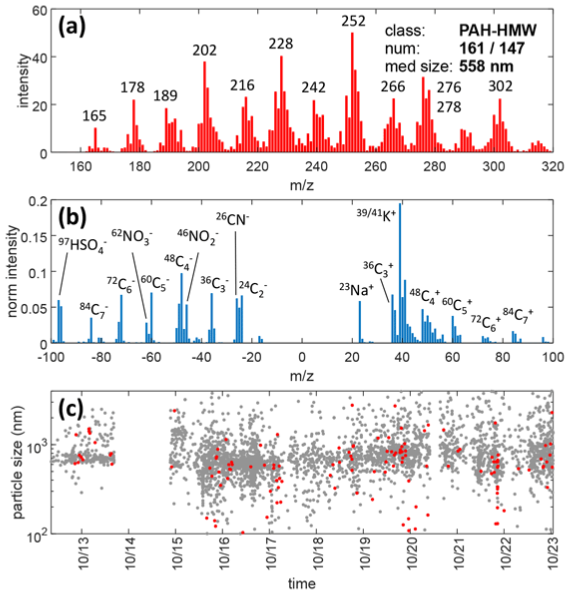Abstract
We investigated the distribution of polycyclic aromatic hydrocarbons (PAHs) on individual ambient aerosol particles at the Swedish western coast in a pristine environment for 10 d in October 2019. The measurements were carried out using new technology with single-particle mass spectrometry (SPMS) that reveals both the inorganic particle composition as well as the particle-bound PAHs (Schade et al., 2019). More than 290 000 particles were characterized; 4412 of them reveal PAH signatures. Most of the PAH-containing particles were internal mixtures of carbonaceous material, secondary nitrate and metals from distant sources in central and eastern Europe. We characterize the aerosol with respect to the inorganic composition, comparable to conventional SPMS, before we discuss the distribution of PAHs within this particle ensemble. Vice versa, we analyze the single-particle PAH spectra for characteristic patterns and discuss the inorganic composition, origin and atmospheric processing of the respective particles. The study period comprised different meteorological situations: clean air conditions with winds from the North Sea/Kattegat and little terrestrial air pollution, long-range transport from eastern Europe and southern Sweden, and transport of aerosols from central Europe over the sea. For all meteorological conditions, PAHs were detected in particles whose inorganic content indicates traffic emissions, such as combinations of soot, iron and calcium as well as in particles with biomass-burning signatures. However, there were variations in their amounts, dependent on the geographic origin. Because of strong mixing, rapid degradation and speciation limits, e.g., for PAHs of the same nominal mass, the application of diagnostic ratios for source apportionment is limited under the conditions of our study. Nevertheless, the combination with the inorganic content and meteorological data provides unique insights into the particles' origin, aging and mixing state. We exemplarily show how the observation of PAH profiles and inorganic secondary components on a single-particle level can open a new door to investigate aerosol aging processes. To our best knowledge, we herewith present the first comprehensive study on the single-particle distribution of PAHs in ambient air as well as the first set of combined data on PAHs and inorganic composition on a single-particle level.
Graphical Abstract
